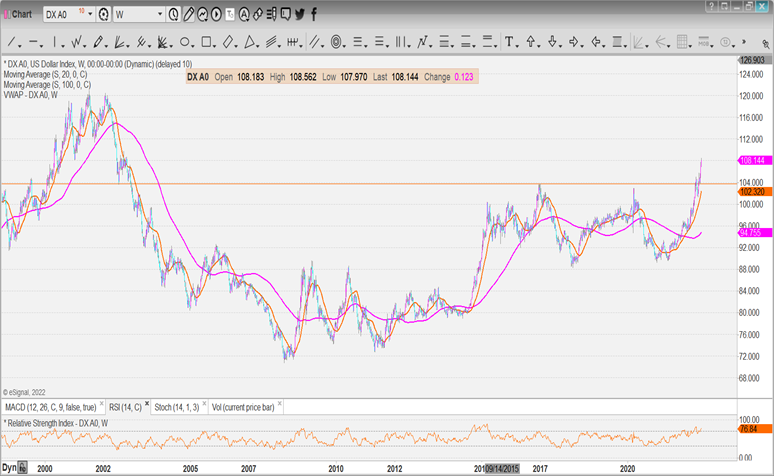The stock market sure doesn’t like the Federal Reserve’s interest rate hikes, states Mike Larson, editor of Safe Money Report.
After all, the SPDR S&P 500 ETF (SPY) has slumped more than 18% year-to-date.
The bond market? Same story. The iShares Core US Aggregate Bond ETF (AGG) has shed just over 10%.
Gold? After holding up well earlier this year, the SPDR Gold Shares (GLD) has started losing ground. It was recently down 5% on the year.
And don’t even get me started on Bitcoin. It has dropped 57% since the start of 2022.
But there is one investment that loves what Fed Chairman Jay Powell is doing. It just had its best month since 2015. It just hit its highest in 20 years. It’s on an absolute rampage against alternatives in many parts of the globe. It’s...
The US Dollar!
Just look at this chart. It shows the ICE US Dollar Index, which tracks the performance of the greenback against six major world currencies. Those currencies are the euro, Japanese yen, British pound, Canadian dollar, Swedish krona, and Swiss franc.
I showed data going all the way back to the turn of the century to give you an idea of how powerful this move is. The index just punched through overhead resistance to hit 108.5, its highest level in 20 years.

So, what does the Fed have to do with the dollar? It’s because relative interest rates are a key driver of currency values. If one central bank’s benchmark rate is, say, 3%, while another’s rate is 1%, global capital will tend to flock toward the former’s currency and away from the latter’s.
Right now, the US Fed has been hiking rates aggressively. That includes last month’s 75-basis-point move, the biggest increase since the mid-1990s.
Powell & Co. have made clear they plan to keep hiking rates as the year goes on, too. That potentially includes another 75 bp move at the meeting that ends July 27.
But the Bank of Japan has vowed not to hike at all for now. Meanwhile, the European Central Bank is only planning its first increase later this month...and it’s expected to be just a 25 bp move. That will put US rates well above rates in other, major developed-economy nations. And that is pumping up the dollar’s value.
What can investors do in response? Well, a rising dollar tends to put downward pressure on commodities and precious metals. It hampers multinational US corporations by making sales earned in foreign markets and currencies less valuable in dollar terms. It also hurts the value of mutual funds and ETFs that track foreign markets.
So, if you’re overloaded with exposure to commodity producers, multinationals, or foreign ETFs, it might be a good time to dial that down. Focus on more-defensive companies with recession-resistant businesses and significant domestic operations. Utilities and consumer staples names foot the bill, and you can find my favorites in the Safe Money Report.
Finally, if you’re planning or departing on a European vacation, rejoice! The strong dollar means your greenbacks will go further the second you touch down in Frankfurt or Rome.




















